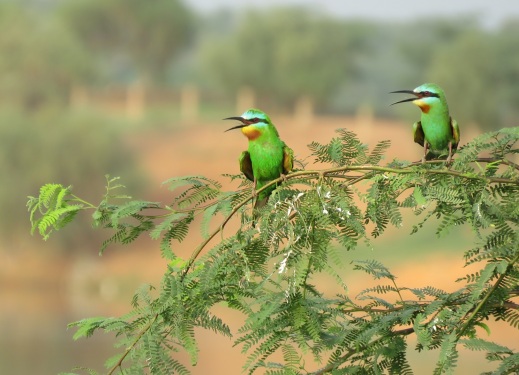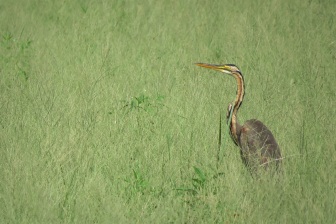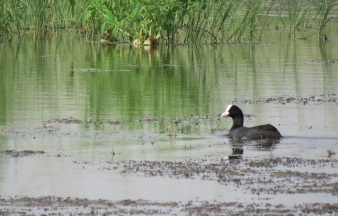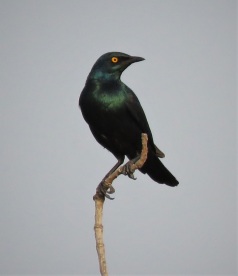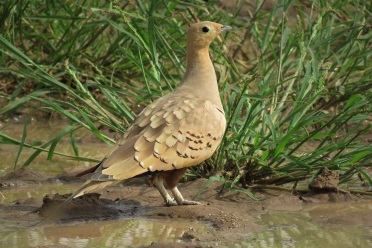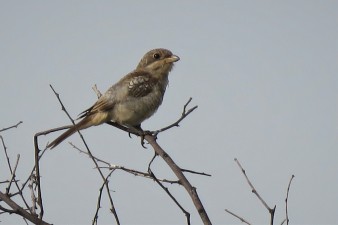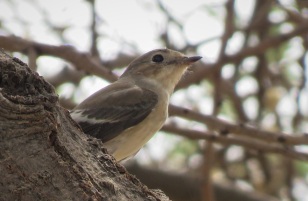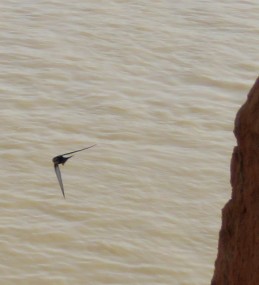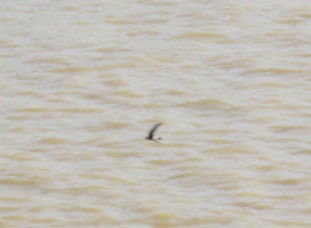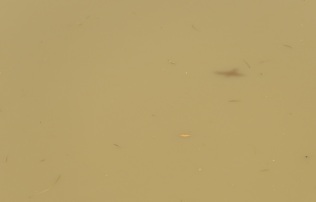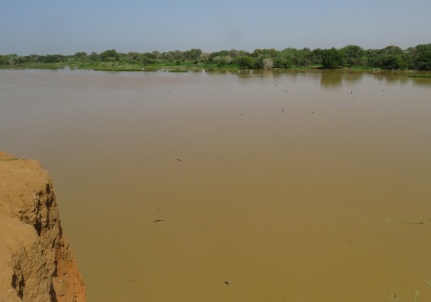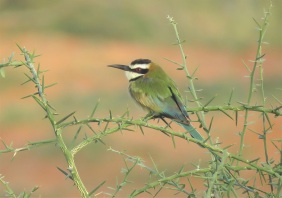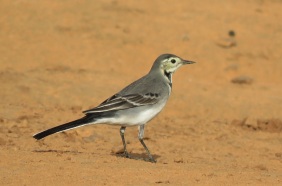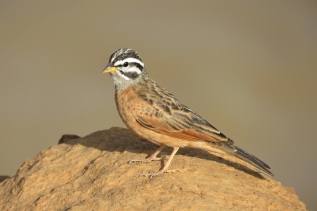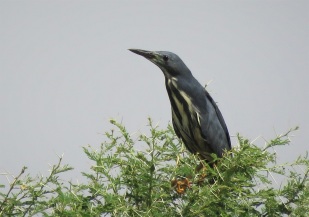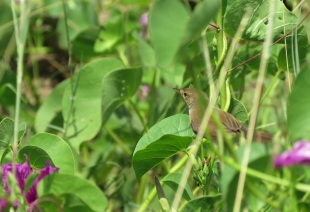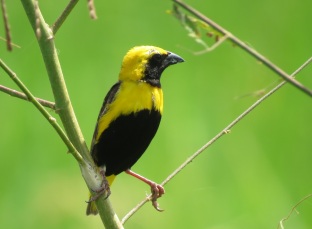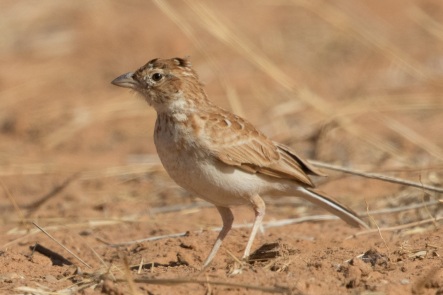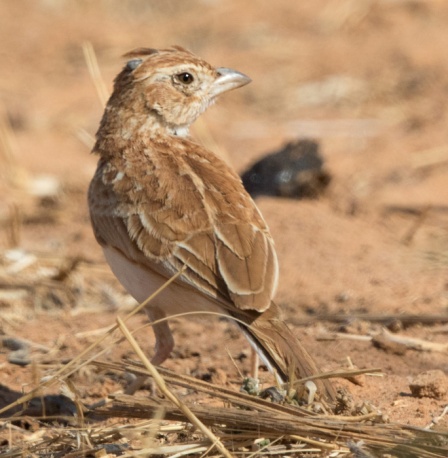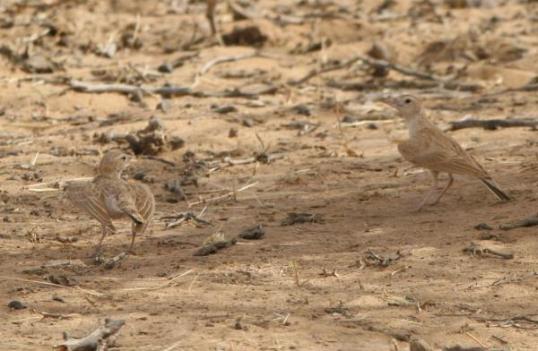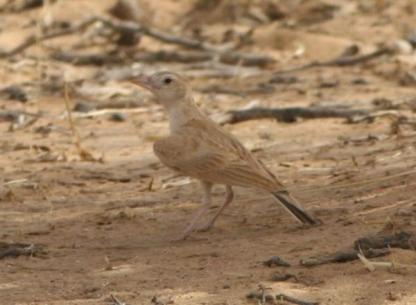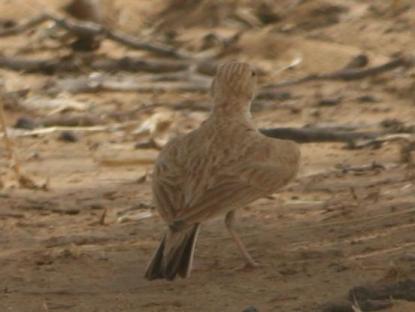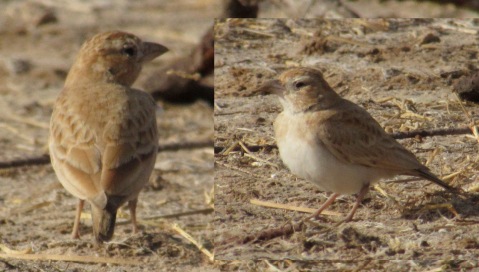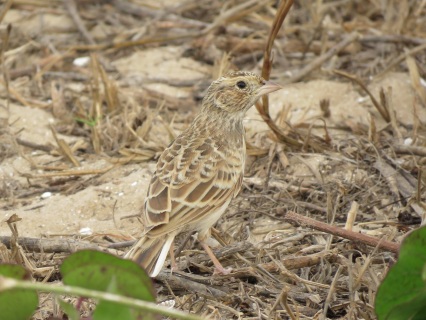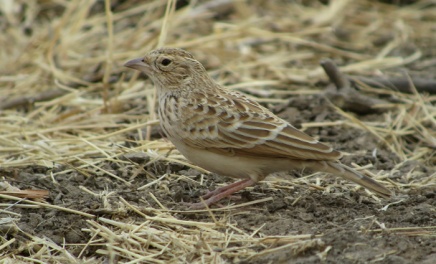Status & Distribution of Seebohm’s Wheatear in Senegal

This is the second part of a review of what we know about Seebohm’s Wheatear in Senegal, the first part covering its identification in autumn and winter. As already mentioned in that piece, this species has a pretty restricted range, breeding only in the Middle and High Atlas of Morocco and Algeria, generally above 1500 meters asl. Until fairly recently it was considered more of an altitudinal or short-range migrant, but it’s clear now that it’s actually a medium-range “total” migrant (i.e. all populations tend to migrate away from breeding grounds – not surprising given that much of it is covered in snow during winter!).

Seebohm’s Wheatear / Traquet de Seebohm m. ad. on breeding grounds at Oukaimeden (Morocco), April 2018 (© F. Bacuez)
The non-breeding range of “Black-throated Wheatear” is given by the Handbook of the Birds of the World Alive as “West Africa (mainly SW Mauritania and Senegal to W Mali, occasionally in S Morocco)”. However, the HBW range map is rather incorrect: all regions of Senegal and Gambia and even Guinea-Bissau are included, although as far as I know the species has never been reported from the latter two countries. The same applies to Guinea and Burkina Faso which are also partly included in the range. Let’s hope that this will get corrected soon – the HBW species page of this newly recognised taxon (formerly considered a subspecies of Northern Wheatear) was only fairly recently published online, and is obviously work in progress.
The winter distribution in Shirhai & Svensson (2018) on the other hand seems more accurate, though perhaps a bit too conservative in that it includes only a very small part of western Mali. Judging by the data available on the Biodiversité Al-Maghrib portal, it’s clear that some birds winter may further to the north, much closer to the breeding grounds. Indeed, there are several observations from southern Morocco and from the Western Sahara from December-February, and it’s easy to imagine that it’s rather beneficial for these birds if they can avoid crossing the Sahara. There are also a few recent records from the Adrar region in Mauritania, e.g. this one and this one by Wim van Zwieten and friends seen at the end of December last year, suggesting that this area may also be part of the species’ winter range.
The Shirihai & Svensson map is most likely largely based on a paper on Seebohm’s Wheatear in West Africa by Förschler and colleagues (2008), which to date gives the most comprehensive overview of our knowledge of its wintering grounds in the Sahel, following field work they undertook in western Niger, Mali and Mauritania combined with a review of published data. They note that “although seebohmi was previously thought to be a resident or only a partial migrant by some authors, it is now considered a true migrant, with the majority of the population leaving Morocco and Algeria in winter. Browne (1982) found a major wintering area, roughly estimated to hold at least 50,000 individuals, in the eastern part of south-west Mauritania […].” They also refer to three more southern records from Djoudj NP (mentioned by Rodwell et al. 1996), and conclude that “the majority of this taxon’s population appears to winter immediately south of the Sahara, in the Sahel zone of southern Mauritania, northern Senegal and north-west Mali between 15–18°N and 09–16°W, although its wintering grounds may range even further east, including parts of central Mali.”

Seebhm’s Wheatear / Traquet de Seebohm, Atar 30 Dec 2018 (W. van Zwieten)
Away from its regular range, there are a few scattered records of Seebohm’s Wheatear in the Mediterranean and one from the Netherlands (April 2017), plus a couple of possible sightings from the UK: Italy (one in April 2014 in Sardinia), Gibraltar, Malta, Tunisia, and several times in the Libyan desert and even once from western Egypt. It’s also on the list of the Canary Islands, and apparently also reported from Cameroon, as per Arnoud B. van den Berg on DutchAvifauna,nl). So it’s definitely a species to have on one’s radar when encountering an unusual wheatear in western and southern Europe; I can imagine that one day a fine male will show up in spring in the Camargue, the Spanish coast or on the Balearic islands – or pretty much anywhere north of its range for that matter.
Status & Distribution in Senegal
In Senegal, in addition to the aforementioned Djoudj records, the species has been reported from the Richard-Toll, Dagana, Podor and Ndioum areas, and at least once from the lower Senegal valley, on 2.3.09 by Frédéric Bacuez, Ornithondar. Of course, Frédéric had already provided a comprehensive overview of the distribution of Seebohm’s Wheatear in Senegal, more precisely in this blog piece from 2016. The Morels mention several spring records (13 March – 14 April) in the middle Senegal valley as far upstream as Salde, plus one from early January 1981 near Richard-Toll seen by Alan Tye. They also report the presence on two occasions some 60 km south-east of Richard-Toll. But that’s about it: not an awful lot of records to go by! It’s quite possible that it may also be found at least occasionally in the Ndiael reserve, around lac de Guiers and into the Ferlo (e.g. Six Forages). These sites are not very often visited by birders or ornithologists, and the recent records that I came across are typically from Richard-Toll and the Podor areas, with the exception of a first-winter male at Saot (ENE of Touba), seen by J-F Blanc in January 2010. No records are known from the Grande Côte, though it’s not impossible of course that the species shows up here at least from time to time.
As can be seen from the map below, northern Senegal is on the southern edge of the species’ winter range, which may explain why most birds seen here appear to be first-winter birds. Adults, and in particularly males, may well winter further north including on the other side of the Sahara as mentioned earlier. Though it’s certainly not rare, the species seems to be nowhere common across its range in Senegal. When we toured the middle valley in January last year, we saw the species in small numbers (1-2 ind. per site) at three different locations: Bokhol, in a sparsely wooded dune depression east of Ndiayene Pendao, and at Gamadji Sare. Some sites such as the Bokhol “fores” appear to be pretty reliable, and a dedicated search would probably reveal other sites where they may be regular and maybe even locally common; in 1973 Seebohm’s Wheatear was said to be “the most common [wheatear] species in winter in the Podor region”, while Sauvage & Rodwell refer to a total of 18 ind. seen at three locations in February 1993 in the Podor atlas square. There may of course be annual variations, possibly depending on any cold spells in north-west Africa, but obviously more data are needed (as usual!).
The majority of sightings are made between December and early March, but this is when most birders visit the country and it’s likely that Seebohm’s is regularly present at least from (mid?) October and up to early April. In Nouakchott, it’s been seen as early as the end of September (see Rob Tovey’s eBird checklist with two pictures of a fresh autumn male), but when I last visited the Podor region in early October 2018 I did not see any birds on the sites that held several wintering individuals back in January, so it seemed that they had not arrived yet at that time.

Seebohm’s Wheatear / Traquet de Seebohm 1st winter m. on wintering site in northern Senegal, Jan. 2018 (B. Piot)
In short, the main wintering area of Seebohm’s Wheatear lies in Mauritania, northern Senegal and NW Mali, on the edge of the Sahara and in the northern Sahel zone. It is a regular winter visitor to northern Senegal, being scarce locally fairly common along the middle Senegal Valley, from October/November to March or early April.
The main winter range in West Africa should look something like this, though it possibly extends a bit further south in Senegal and further east along the Mauritania-Mali border. And as mentioned already, some birds may winter in southern Morocco and in the adjacent Adrar region of Mauritania, as well as along the coast north of Nouakchott: the below map may well need to be adjusted as such – comment welcome, as usual.

Approximate extent of main winter range of Seebohm’s Wheatear / Etendue approximative de l’aire d’hivernage du Traquet de Seebohm
Habitat
While its habitat in summer essentially corresponds to Alpine meadows with rocks and stone structures, usually devoid of any trees, in winter the species may inhabit light Sudano-Sahelian woodland, at least along the Senegal valley. Elsewhere, particularly further north in Mauritania, it probably occurs mostly in more open habitat. The Bokhol forest just east of Dagana seems to be a reliable place to find Seebohm’s Wheatear: it is comprised of a mix of Acacia, Balanites aegyptiaca and other trees growing on sandy soil with little or no undergrowth. Indeed, most of the winter range of the species is heavily overgrazed anyway, and away from the floodplains there is generally very little vegetation cover… the picture below gives an impression of the the sad state of what remains of northern Senegal’s “forests” – a very liberal concept here at these latitudes.
We’ve also encountered the species on several occasions at Gamadji Sare, where part of the area is also made up of light woodland, not dissimilar to Bokhol, though less mature. Some birds here were seen in more open areas, including right by the bank of the Doué river where this picture was taken:
In much of its range, the species is cohabiting with Northern (ssp. oenanthe and probably also libanotica), ‘Greenland’ (leucorhoa) and Isabelline Wheatear, probably locally also with Black-eared and Desert Wheatears though the latter two species are typically very scarce in Senegal it seems. Heuglin’s Wheatear is also possible in winter in northern Senegal, but it’s much rarer and was added to the national list only recently, following a record in the Djoudj NP in January 2007 (and was found breeding even more recently in the Kédougou region).
A brief etymology¹ of Seebohm’s Wheatear
The HBW Alive lists this taxon as Black-throated Wheatear, another rather boring and unimaginative English name. I’ll stick to Seebohm’s. Alternatively, Atlas Wheatear would be a pretty good one as it nicely highlights the restricted breeding range of the species; this name is already in use in Spanish and German, and no doubt in other languages.
But actually, why Seebohm’s Wheatear? Tim Birkhead – author of (at least) two great books, The Wisdom of Birds and Bird Sense – wrote about Henry (or should it be Harry?) Seebohm, a 19th century British industrial and ornithologist, most famous for his fieldwork in Siberia. Which doesn’t really explain why our wheatear from the Atlas goes by his name… enter Charles Dixon, who formally described the taxon in 1882 based on a specimen from the Algerian Atlas. A contemporary of Seebohm, Dixon collaborated on Henry Seebohm’s British Birds opus, so I think it’s safe to assume that Dixon named his newly described chat in honour of his friend.
The term “wheatear” apparently comes from “white” and “arse”, referring to the prominent white rump found in most species.
¹ Etymology is the study of the origin of words and the way in which their meanings have changed throughout history. Applied to vernacular and scientific bird names, this comes down to retrieving the origins of these names.
Thanks once again to Frédéric Bacuez and Wim van Zwieten, and now also to Jérémy Calvo for making available some of their pictures from Mauritania and Morocco

Seebohm’s Wheatear / Traquet de Seebohm m. ad. on breeding grounds at Oukaimeden (Morocco), April 2018 (© J. Calvo)
Identification of Seebohm’s Wheatear in Senegal

Last winter, I had the chance to have a closer look at a species that is relatively little-known, particularly on its wintering grounds: Seebohm’s Wheatear, a former subspecies of Northern Wheatear that was fairly recently (though long overdue it seems) recognised as a full species by many authors, though surprisingly not yet by IOC. These neat little birds have a pretty restricted breeding range, only occurring in the Atlas mountains of Morocco and Algeria. A couple of years ago I had the chance of seeing these birds for the first time, more precisely in May on their breeding grounds at Oukaimeden, birding hotspot incontournable of the Moroccan High Atlas. As such it was particularly nice to meet up with them on their Sahelian wintering grounds a few months later, during our memorable trip up north in January 2018.
Wheatears can be tricky birds to identify, with several species often posing a bit of an ID challenge, and Seebohm’s is no exception. However, nothing much has been written about the identification of first-winters and adults in non-breeding plumage¹, and depictions in standard field guides may be misleading or even incorrect. In an effort to further our knowledge of the species, we thought it may be useful to summarise what we know based on our limited experience with Oenanthe seebohmi in the field here in Senegal, combined with a brief study of available pictures. Note though that by no means is what follows necessarily a comprehensive overview; additions and corrections are most welcome as usual.
A second blog post will focus on the status & distribution of the species.

Identification in winter
While straightforward to recognise in spring, Seebohm’s Wheatear on its Sahelian wintering grounds can be difficult to identify, mainly because they may superficially resemble Desert or Black-eared Wheatear, while young birds and some females may look like Northern Wheatear. We’ll start by reviewing field characters as found in the most relevant literature: mainly the excellent Robins and Chats (Clement & Rose 2015), Nils van Duivendijk’s Advanced Bird ID Guide (2010), and the recently published seminal reference guide by Shirihai & Svensson (Handbook of Western Palearctic Birds: Passerines, 2018). Let’s see how these can be applied to some of the pictures of presumed Seebohm’s taken in winter.
- Size & overall impression are very similar to Northern Wheatear, though it is slightly smaller than that species – something that’s not necessarily obvious in the field unless maybe in direct comparison to nominate Northern; it’s clear though that Seebohm’s definitely doesn’t look larger than Northern as is the case with ‘Greenland Wheatear’ (= ssp. leucorhoa) where the size difference is usually obvious in the field.
- Structure is typical of wheatears and does not appear to be very different from Northern either; the wing is supposedly slightly shorter, though this is not really obvious in the field, several of the pictures presented here actually show rather slender long-winged birds with an important primary projection, rarely giving a more compact appearance. On most pictures presented here we can however verify that the primary projection is slightly less than the length of exposed tertials (Shirihai & Svensson).
- The bill and tail are said to be “rather longer” than Northern, but these differences are again likely of little use in the field, and I’d imagine that there’s some overlap between species – more measurements on museum skins are likely needed to confirm this.
- In all plumages, the black terminal tail band is narrower than in Northern Wheatear (on outer tail feather, ca. one third of the length of the feather is black), though yet again this is not a very useful field character unless good pictures of the tail are obtained.
- Another key difference is that the underwing coverts are entirely black in males, while in females there are pale streaks on dark underwing coverts, unlike in Northern.

Seebohm’s Wheatear / Traquet de Seebohm, Bokhol, Feb. 2018 (F. Bacuez) showing blackish underwing coverts.
Adult and second-year males are generally straightforward to identify in autumn and winter, when they largely retain their distinctive head pattern, only to a limited degree obscured by pale fringes, combined with very pale underparts and “largely greyish or slighly sandy-grey” upperparts. As a result, adult males should be easy to pick out in autumn and winter, despite not showing the crisp black/grey/white plumage typical of spring males. Still, they remain very distinctive and are unlikely to be confused with any other species, such as this one from the end of March on wintering grounds in southern Mauritania, photographed by the late Robert Tovey (Birding for a lark blog):

Seebohm’s Wheatear / Traquet de Seebohm, m. ad. in spring, Aleg (Maurtiania), 31 March 2018 (© R. Tovey). Note pale buff undertail and lower vent, but otherwise white underparts
The two birds below were photographed in Nouakchott by Rob Tovey, at the end of September and mid-October, respectively. Both are clearly males, and while not very grey, I believe both are 1st year birds (note moult limit on first bird). However, ageing of these birds “requires close inspection of moult and feather wear and pattern in wing” (Shirihai & Svensson) and is often not straightforward – more on this below. This bird on Afbid from January near Richard-Toll, photographed by Nik Borrow, clearly shows an adult-type male, with a largely grey crown, mantle and scapulars.

Seebohm’s Wheatear / Traquet de Seebohm, m. ad. in autumn, Nouakchott (Maurtiania), 23 Sept. 2017 (© R. Tovey). Note cold colours, grey & pale brown back, slender appearance, very pale underparts and longish pointed bill

Seebohm’s Wheatear / Traquet de Seebohm, m. in autumn, Nouakchott (Maurtiania), 15 Oct. 2016 (© R. Tovey). Fairly similar bird to the previous one but browner and less marked on chin and throat.
There appears to be some confusion about the plumage of adult females in the literature, with some authors only mentioning that adult females have a “(dark) grey mottled throat” (van Duivendijk), whereas Svensson in the Collins Bird Guide writes that “females and imm. are often inseparable from [Northern] Wheatear unless showing hint of mottled grey throat (rare though)”. Clement & Rose provide illustrations of an adult male and a dark-throated adult female, but don’t bother illustrating typical females, nor do they show any birds in autumn and winter. They do note that females are variable, ranging from closely resembling typical females of Northern Wheatear, to showing brown ear-coverts and having black or blackish-brown lores to chin and throat tipped with buff, grey or sandy colour – thus more resembling the males in head pattern. Not very clear!
Luckily, Shirihai & Svensson are more precise, stating that adult females are “almost identical to ad. f. (and young m.) libanotica Northern Wheatear, and contrary to previous descriptions nearly always lacks dark bib.” Black- or grey-throated females are thus considered rare. They go on to describe the upperparts as “largely pale grey (with limited sandy-brown suffusion) including on crown. Usually has duskier or almost blackish lores and ear-coverts; whitish supercilium often narrow and short, hardly extending to forehead […].”
Here’s a typical female in spring on the breeding grounds at Oukaimeden, and this picture on Afbid is from May at Ifrane. Adult females in autumn are said to be much as in spring but warmer.

Seebohm’s Wheatear / Traquet de Seebohm f. at the end of April, Oukaimeden (© F. Bacuez). This bird may appear darker than usual because of the drab conditions and poor light (yes that’s snow falling there!)
The ageing criteria for first-winter birds, according to van Duivendijk, are as in Pied Wheatear [everyone knows these criteria by heart, right?!]: primary coverts with slightly frayed broad white fringes (ad autumn: often narrower and sharply bordered); primaries brown to brown-black often with pointed and worn tips; pale fringes to secondaries complete and cream-coloured; sometimes moult limit visible in greater coverts. There you go, just in case you’d forgotten. Ageing is thus largely based on moult limits, with first winter birds retaining juvenile primaries, primary-coverts and outer greater coverts, whereas in adults these are evenly fresh.
Back to Shirihai & Svensson, who state that first-winter males are “more female-like and rather feature-less, but still approaches fresh ad. m., having greyer upperparts and darker face with exposed black mottling especially on sides and lower throat; warmer below (Variation poorly known and requires more study)”, and that first-winter females have the “least contrasting plumage, with paler face pattern, and browner/duller ear-coverts.”
Let’s put the above to the test on some of our pictures from Senegal!
The following four photographs show three different birds from January; all are presumed to be first-winter males with varying levels of black extent on the face and throat. I initially assumed these to be adult males, but judging by the description of non-breeding males (by Shirihai & Svensson mainly) and compared to some of the pictures presented earlier on and those in Förschler et al., I now tend to label them as first-winter birds – mainly because of the overall sandy-coloured upperparts, mostly lacking grey tones. Again, keep in mind that ageing of these birds can be tricky and is not always possible! In the first bird, note the largely black throat and face appearing rather “smudged”, a fairly large white front merging into a clear whitish eyebrow extending well beyond the eye, and largely pale sand-coloured mantle and scapulars, the latter with a hint of light grey. The wings in the bird below appear relatively contrasted black and white, with extensive white fringes to the secondaries.
In this picture of the same bird, the greyish scapulars and some grey mottling on the back are more apparent:
This one taken earlier that same day in a different location shows a bird with less white on the chin and gives a very “cold” impression, though this is certainly exaggerated by the subdued early morning light. See also this picture of the same bird, as well as the second picture in this post (the one with spread out wings) which may well show the same bird, five weeks later in the same spot. Not sure about sex here – probably a male, but we probably can’t exclude a dark-throated female.

Seebohm’s Wheatear / Traquet de Seebohm, Bokhol, Jan. 2018 (B. Piot). Besides the black “smudge” on the face, note the cold colours and pure white underparts. Tentatively identified as a first-winter male.
The same goes for this one from last December, taken by Wim van Zwieten near Podor. This bird also has fairly little black on the face but extensive pale fringes to greater and primary coverts as well as to secondaries, suggesting a first-winter male, though again not sure it can safely be sexed. These birds may be mistaken for Desert or Black-eared Wheatear (the black-throated form of which sometimes occurs in Senegal, though it’s probably rare), even by experienced birders.
The next bird gives a very pale impression, with uniform light sandy upperparts and a white lower breast, flanks, belly and vent. The upper breast are warmer tinged with a buffish wash extending down from the ear coverts, and so are the undertail coverts. The black or dark brown loral stripe is reminiscent of Isabelline Wheatear, but it has a narrow yet distinct supercilium both in front and behind the eye and has a different ‘jizz” and wing pattern than Isabelline. I’ve concluded that it’s a first-winter female, but as always would stand happy to be corrected. Either way, the very white underparts and pale upperparts stand out and should immediately point to Seebohm’s.

Seebohm’s Wheatear / Traquet de Seebohm presumably 1st winter female, Gamadji Sare, Jan. 2018 (B. Piot).
Of course, identifying a female or 1st winter bird in a vagrant context is something else. While not necessarily impossible, it will require a combination of characters as well as proper photographic documentation of underwing and tail pattern in particular. There have been at least two suspected birds in autumn in the UK but which could not be confirmed as definite Seebohm’s (read up more on these tricky birds here on Birding Frontiers). The first confirmed sighting for NW Europe was of a male in May 2017 in the Netherlands, a typical case of “overshooting” by North African or Mediterranean species during spring migration. Elsewhere in Europe, the species has been reported as a vagrant from Gibraltar, Italy, Malta, the Canary Islands.
Stay tuned for part II!
– Bram, with thanks to Frédéric, Simon, and to Wim for the use of his picture. And most importantly, a posthumous tribute to Robert Tovey who in a short few years made valuable contributions to our knowledge of birds in Mauritania, before unexpectedly passing away in September last year.
¹ Note (19.2.19): The only exception is actually a remarkable paper written by Mayaud in… 1951, in the French journal Alauda (19:88-96): Le plumage prénuptial d’Oenanthe oenanthe seebohmi (Dixon), in which the author provides a detailed description of birds in non-breeding plumage.
Identification of Kordofan Lark and Status in Senegal

Kordofan Lark (Mirafra cordofanica) is a poorly documented African lark species occurring in the Sahel. In West Africa it is known from Mauritania, Mali, Niger and Burkina Faso and its status in Senegal is considered to be that of a vagrant. A recent observation by a Belgian tour group led by Miguel Demeulemeester in March 2018 gives us a good opportunity to have a closer look at this species’ identification and its occurrence in Senegal.
Despite the quite broad range occupied by Kordofan Lark, which covers eight countries, it appears to be a highly localized resident. It is quite remarkable to note that there is not a single picture or video available on the Internet Bird Collection, nor are there any sound recordings on xeno-canto and other online sound libraries! It is probably the only bird species found in Senegal in that case. This is probably because the countries where the species is regular are not top birding destinations nowadays. A thorough internet search only takes you to a set of pictures taken in Niger by Tim Wacher, though it appears that these birds are actually Dunn’s Lark and not Kordofan as initially thought – see further down for a discussion of identification. The pictures taken by Jan Heip are therefore a very good contribution to the online presence of this scarce lark. As it turns out, they may well be the only pictures available online!
Kordofan Lark in Senegal
The first record of the species has been published by Morel & Roux (1962). Since this first observation a few more records have been added, which in most cases are not documented.
- Collected or observed 4 or 5 times in grassland close to Richard Toll, April to June 1960 (Gérard Morel)
- One close to Bakel, January 1983 (H. Schifter in Morel & Morel 1990)
- At least one in the Richard Toll area, during a visit from 30 December 1993 to 5 January 1994 which “produced single records of Golden Nightjar, Little Grey Woodpecker and Kordofan Bushlark […] (per TG).” (Recent Reports, African Bird Club)
- One record of a single bird NE of Louga (15°41´N, 16°7´W) on 30 July 2004, during North-South transects as part of a study on bird population densities along two precipitation gradients in Senegal and Niger (Petersen et al. 2007)
- 4 individuals, Ndiaël, 4 December 2004 (Richard Cruse in Recent Reports, African Bird Club Bulletin)
- 1 individual, southern part of Ndiaël, 14 February 2006 (Richard Cruse in Recent Reports, African Bird Club Bulletin)
- One individual feeding close to Richard Toll, March 1st 2018 (Miguel Demeulemeester et al.)
There have been a couple of claims in the past years that refer to other lark species, and probably undisclosed genuine observations as well, as most observations of guided tours remain in notebooks. Most Kordofan Lark records from Senegal should be considered with care when they are not documented.
Kordofan Lark in surrounding countries
In Mali the species is reported as uncommon but widely distributed from 15°N to 23°N by B. Lamarche (1980), adding that the species undertakes local movements with evidence of breeding from May to July near Tombouctou. In mid-June 2004, several Kordofan Larks were in song in sand dunes south-west of Gao, where the spiky grass Schoenefeldia gracilis was dominant (Robert Dowsett & Francoise Lemaire; ABC Bulletin). Similarly, L. Fishpool recorded the song in June in NE Burkina Faso, by a bird “perched on a bush 2m above ground, on sandy soil (mainly of reddish tint)”. This recording was included in the legendary set of sound recordings of African birds by Claude Chappuis (2000).
For Mauritania the following information is given by Isenmann et al. (2010). The Kordofan Lark is thought to be a resident breeder in the Sahelian part of the country. Gee (1984) only found this lark 50-60 km north of Rosso where it was rather common and probably breeding (displaying and diversion behaviours). This location is close to the Senegalese border, and all observations of Kordofan Lark in northern Senegal most likely refer to birds breeding in this area, as there is not yet any evidence of breeding in Senegal. In fact, the species is so poorly known that its nest and eggs remain undescribed.
Identification
As written by Nik Borrow & Ron Demey in their reference bird guide, Kordofan Lark is a “small, pale sandy-rufous lark with stout whitish bill and distinctive tricoloured tail pattern (rufous, black and white). When fresh upperpart feathers fringed buff with narrow blackish subterminal crescents”. Its structure is rather similar to Singing Bush-Lark, but the plumage is noticeably different. The picture shows a head and breast pattern that nicely fits the plate in Borrow & Demey, with limited well-defined brownish streaking on the upper breast, sandy-brown head with paler supercilium and nape and a white throat patch extending below the ear coverts. The bird also shows a few fresh scapulars with a neat white fringe and a subterminal dark bar, typical of the species. Its bill also perfectly corresponds with the description given in the Handbook of the Birds of the World, describing the bill as “pale whitish horn, slightly darker tip and dorsal side of upper mandible“. The juvenile is said to have “broader pale feather fringes on back and wing-coverts, heavier dark spotting on breast“.
To sum up, the main characters to look at are the bicoloured bill, brown-rufous upperparts, pattern of fresh upperparts feathers, upperbreast streaking, pale supercilium and the tricoloured tail. These characters are a unique combination amongst larks from the desert.
The group of birds photographed by Tim Wacher show a very pale plumage without breast streaking or contrasting upperparts, an entirely pale bill except for the tip, and no rufous tones in the plumage. At first sight the tail pattern (and length) fits Kordofan, but it lacks the rufous central tail feathers that should be obvious here, and which are clearly visible on the Richard Toll bird. The central tail feathers in the birds below appear more sandy brown than rufous/rusty. These birds also don’t show any white-tipped mantle feathers. As already suspected by Tim, the features shown by these birds thus correspond much more with Dunn’s rather than Kordofan Lark – including the tail pattern, which is quite similar to what can be seen here for example. It’s important to point out (thank you Tim!) that the tail of Dunn’s Lark can apparently also show a considerable variation in length, and that the white margins visible in the photos from Niger are not always evident (or present?).
We’re including the pictures here for comparison purposes, and also because Dunn’s Lark is likely to be found at some point in northern Senegal, given its nomadic habits and that it occurs not far over the border with Mauritania.
Beware also of the possible confusion with rusty females of Black-crowned Sparrow Lark, which can look superficially similar, but show a different tail pattern and proportions. The shorter tail and legs combined with a proportionally large head give a plump silhouette to the bird. Sparrow-larks are also smaller and more compact, and their upper breast is not streaked.
The only other Mirafra species occuring in Senegal is the Singing Bush Lark Mirafra cantillans. This species is fairly common in dry savanna and grassland, and shares some characteristics with Kordofan Lark. The bill can be similarly coloured, the tail can appear tricoloured as well (though less obviously so, and less neatly separated, than in Kordofan – check out variations below) and upper breast is also streaked. In adult plumage the upperparts of Singing Bush Lark is scaly, identification is then straightforward. But in fresh plumage Kordofan Lark shows a scaly plumage as well, thus separating both species can become tricky.
Then what to look at? Global coloration of upperparts seems to be the clue, ground colour being cold sandy-brown for Singing Bush Lark and cinnamon-rufous for Kordofan Lark. Pay also attention to the fresh upperparts feather pattern, Kordofan Lark showing a clear dark subterminal band absent in Singing Bush Lark (this dark line remains on the photographed Kordofan Lark, which shows a fairly worn plumage; this detail is probably only visible at close range). Singing Bush Lark, at least in fresh plumage, typically has a more contrasted head pattern and appears more mottled overall, especially on the mantle and shoulders, with stronger breast streaking than Kordofan.
Obviously, much is still to be learnt about the various Sahelian larks, be it in terms of identification, status & distribution, or ecology!
A few references
Gee, J.P. (1984). The birds of Mauritania. Malimbus 6: 31-66.
Isenmann P., Benmergui M., Browne P., Ba A.D., Diagana C.H., Diawara Y. & El Abidine ould Sidaty Z. (2010). Birds of Mauritania – Oiseaux de Mauritanie. Société d’Etudes Ornithologiques de France, Paris, 408 p.
Morel G., Roux, F. (1962). Données nouvelles sur l’avifaune du Sénégal. L’Oiseau et la Revue Française d’Ornithologie 32: 28-56.
With thanks to Jean-Francois Blanc, Miguel Demeulemeester, Jan Heip, Tim Wacher.
Simon & Bram























